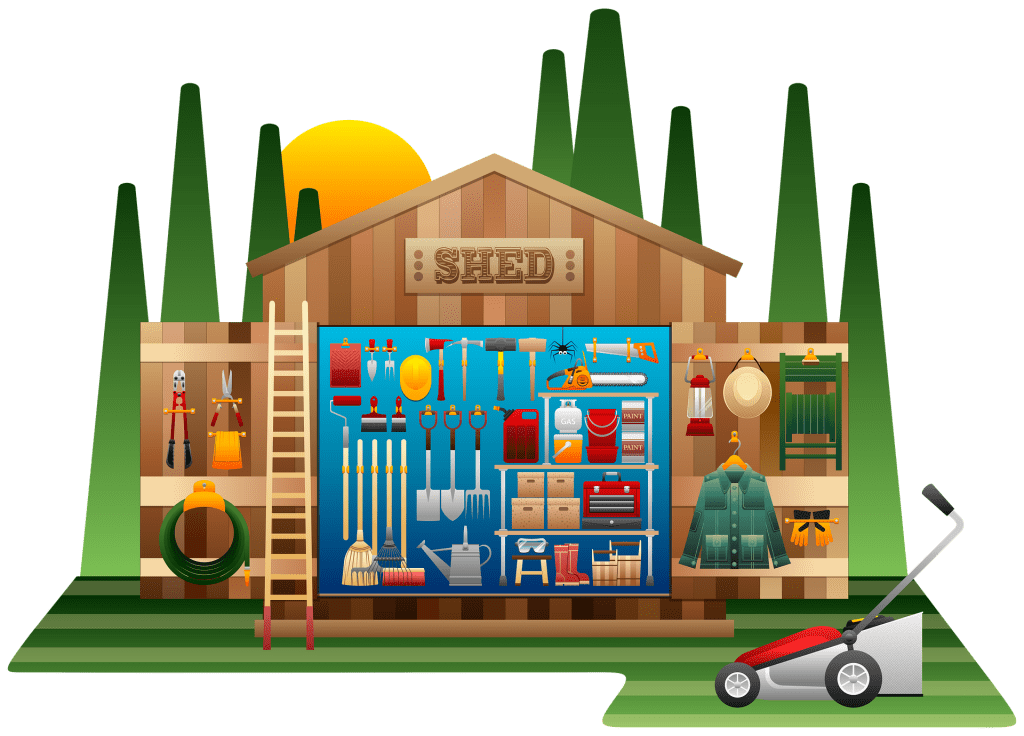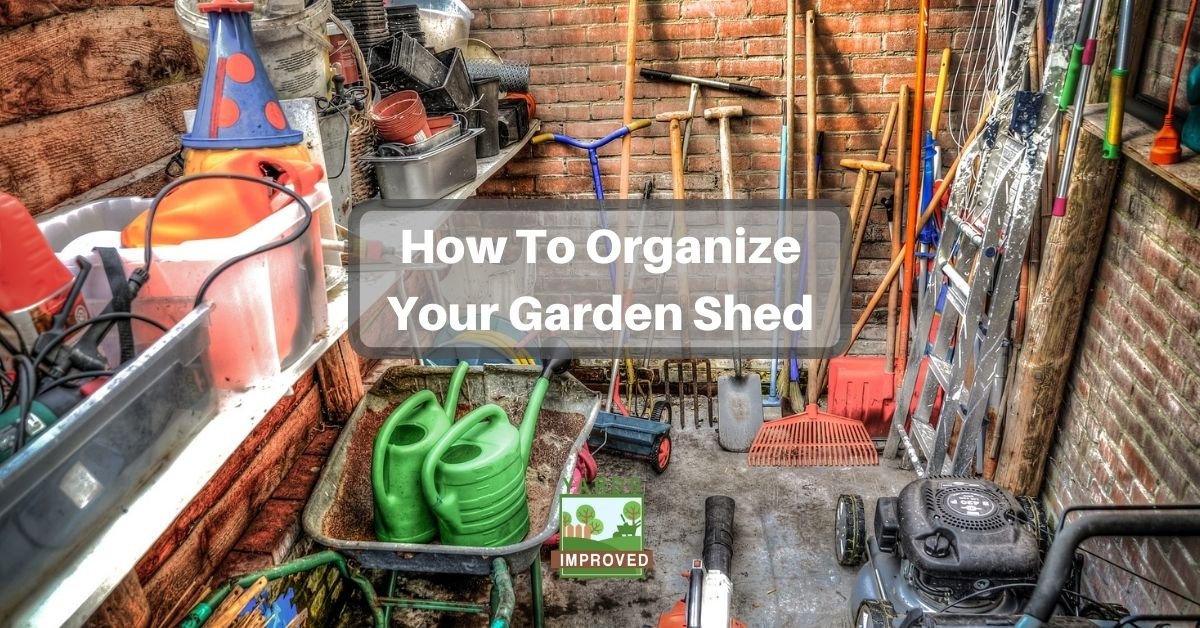To take good care of your lawn and garden, you need more than a few tools. That also means you need a place to store them! A garden shed is the perfect place for that. But to keep it organized and have all the tools easily accessible takes a bit of planning and care.
Fortunately, shed organization isn’t hard. It just requires a bit of discipline. It’s pretty basic – there’s a place for everything, and everything should be returned to its place. Sounds like something we learned in kindergarten, right? Unfortunately, it’s easy to let things get out of hand. And that costs us time in the short run – and can lead to damage to our tools in the long run.
While we’ll talk about “sheds” here, the tips we have can apply to any storage area. That could include a garage, basement, mudroom, or whatever other space you can store your equipment in. So don’t feel left out if you don’t have a dedicated building for your garden and lawn tools!
So let’s dive in and go over the basic steps that can help your shed not only look better but also serve you more efficiently!
Keep Safety The #1 Priority
Safety has to be the prime consideration, however you decide to store your tools. We’ll talk about ways to hang things on walls or overhead. We’ll have hooks on doors and walls. But before doing any of that, be sure to ask yourself if it would present a danger.
Any pegs, hooks, nails, or other ways to hang things should be safe and secure. Don’t hang heavy tools overhead. Not only could they fall on their own; they could also slip when you try taking them down. Or you could strain your arms, neck, or back manipulating them.
Remember that tools can both be heavy and sharp. Keep in mind that you – and perhaps other family members – will be moving among them in a relatively small space. Don’t put anyone at risk just to keep the tools out of the way.
Leave Space For Large Tools And For Moving Around
It’s also important that you leave space for all your equipment. If you plan to store a ride-on lawnmower or a similar device, you want to have everything else along the sides of the shed.
Even a push mower can take a good amount of space. Think about where it can fit into the overall space. Ideally, you don’t want to have to climb over it to get to other tools or have to move it each time you enter the shed. At the same time, you don’t want other tools blocking your access to it.
Hang, Don’t Stack
When you’re tired and in a rush after a hard day of yard work, you could be tempted to toss your tools in a corner. But that soon leads to a jumbled mess!
Looking to buy a pre-built shed? Check out some great ones!
Instead, create a spot to hang each of your tools. There are lots of options, and some of the best are easy DIY projects. Here are a few ideas:
Tool Racks
Pegs and hooks along the walls are great for hanging larger tools like rakes and shovels. You can even hang weed whackers and chainsaws with the right-sized hooks.
You can buy these, but you could also fasten hooks or pegs to a 2×4 and in turn fasten the 2×4 to the wall. This helps maximize your space by keeping these bulkier tools out of the center of your room.
Pegboard
For smaller tools, you can hang a section of pegboard with hooks on it. This is great for your small garden forks, trowels, rose pruners, and the like. Rather than tossing them on a table, you can keep them organized on the wall!
A custom-built shed is a great option, and lets you set up storage just how you want it.
Magnetic Strips
A good substitute for pegboards is a magnetic strip that your tools will stick to. Rather than a 2×4, you simply attach the magnetic strip to the wall. It can hold many smaller tools as long as they’re made of metal.

Repurpose Old Cabinets
If you’ve remodeled the kitchen or bathroom, you may be left with old cabinets. These are great for storage, and even provide a small workspace for your shed!
You can use the drawers for smaller tools and keep larger ones in the cabinet space. Hang pegboard or a magnetic strip on the wall behind lower cabinets to maximize the available wall space.
Invest In Shelves
Shelving is another great option. You can still get metal workshop shelves, but it’s more common and economical today to use plastic shelving units.
You can place anything that fits on these shelves, but we like to use them for chainsaws and toolboxes. Yes, we do keep a toolbox handy in case we need to do some basic repairs!
Basically, shelves are our go-to choice for objects that are too awkward to hang and too big for cabinets and drawers.

Use The Overhead Beams
Many sheds have overhead beams or supports that make great places to hang items from.
We recommend not hanging anything heavy, since it can be dangerous trying to hang it or take it down.
However, you can attach hooks to the beams for hanging rope or extension cords. It keeps them from getting tangled and you’ll always know where they are!
Store Small Items In Jars
If you need to store smaller items in the shed, such as nuts, bolts, and screws, clear glass or plastic jars are great! Look for containers with wide mouths and screw-on lids.
You can nail the lid to the underside of a board or shelf, then screw the jar off of it when you need something. This helps create extra space and keep your work area and shelves clear.
If you can’t find clear containers, be sure to label them carefully!
Clean Up Spills
Keeping your shed organized should also involve keeping it clean. But sometimes accidents happen. There are a lot of things that could spill in the shed, including oil and gas.
Be sure to clean them up promptly and dispose of any rags that may have absorbed hazardous materials like fuel.
When left unattended, these spills could harm any tools that come in contact with them – and to the structure of the shed itself.
Avoid Attracting Bugs
You also want to take steps to keep pests out of your shed. Typically, a shed isn’t as insulated or protected from bugs, rodents, and other unwanted pests as your house. But these animals can still enter and cause destruction.
As far as possible, don’t store pet food, birdseed, or other items that will attract critters to the shed. Instead, keep these in the house inside plastic containers.
If you must keep them in the shed, though, keep them inside sealed plastic storage containers there, too. Exposed bags – even unopened ones – are an invitation to unwanted guests. They can also rot faster because of the lack of temperature control in the shed.
Clean Tools Before Storing Them
Finally, don’t forget to clean your tools before storing them. This will help keep them in good shape for the next time you need them!
Conclusion
A garden shed is a wonderful addition to any property! It makes storage and care of your equipment and tools much easier. But to get the most out of it, you should keep it organized and clean. With hooks, shelves, cabinets, and proper spacing, you can really maximize its use!










